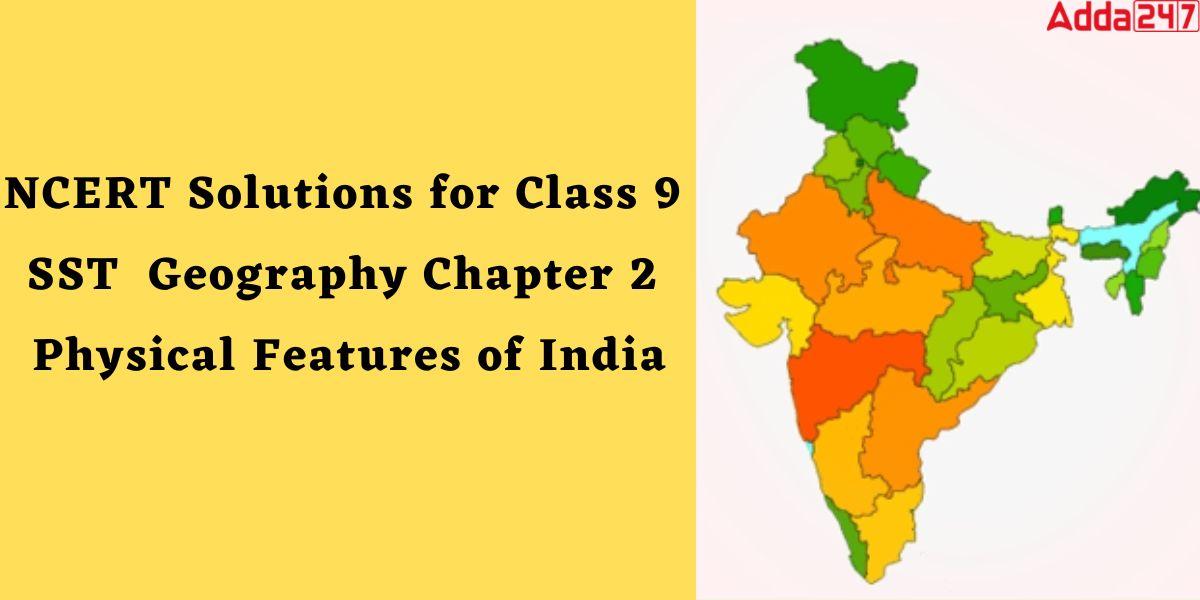Table of Contents
NCERT Solutions for Class 9 SST Geography Chapter 2 Physical Features of India Notes
NCERT Solutions for Class 9 SST Geography Chapter 2 Physical Features of India notes are provided in this article. NCERT Solutions for class 9 is the finest resource for getting a high score on the class 9 Examination. Adda247 Expert faculty team prepared NCERT Solutions for Class 9 SST Geography Chapter 2 Physical Features of India exercises of that chapter for a better grasp of the topics. These NCERT Solutions answer all questions in an easy and simple manner. These solutions will help you understand the concepts covered in the chapter completely. By writing these answers in the exam students will undoubtedly be able to achieve high scores. Keep learning with Adda247.
NCERT Solutions for Class 9 SST Geography Chapter 2 Physical Features of India Pdf
NCERT Solutions for Class 9 SST Geography Chapter 2 Physical Features of India pdf is given in pdf format so students can easily download it for future use. Click here to download NCERT Solutions for Class 9 SST Geography Chapter 2 Physical Features of India
Class 9 SST Geography Chapter 2 Physical Features of India Summary
Class 9 SST Geography Chapter 2 Physical Features of India describes the important geographical features of the country, including the continent, mountains, deserts, and islands. India’s main physiographic divisions have been thoroughly examined. These consist of:
- The Himalayan Mountains
- The Northern Plains
- The Peninsular Plateau
- The Indian Desert
- The Coastal Plains
- The islands
NCERT Solutions Class 9 SST Geography Chapter 2 Physical Features of India Questions with Answer
1. Choose the right answer from the four alternatives given below.
(i) A landmass bounded by the sea on three sides is referred to as
(a) Coast
(b) Island
(c) Peninsula
(d) None of the above
Answer: (c) Peninsula
(ii) Mountain ranges in the eastern part of India forming its boundary with Myanmar are collectively called
(a) Himachal
(b) Uttarakhand
(c) Purvachal
(d) None of the above
Answer: (c) Purvachal
(iii) The western coastal strip, south of Goa is referred to as
(a) Coromandel
(b) Konkan
(c) Kannad
(d) Northern Circar
Answer: (c) Kannad
(iv) The highest peak in the Eastern Ghats is
(a) Anai Mudi
(b) Kanchenjunga
(c) Mahendragiri
(d) Khasi
Answer: (c) Mahendragiri
2. Answer the following questions briefly.
(i) What is the bhabar?
Answer:The Bhabar is an 8–10 km wide strip that crosses the Shiwalik Mountains’ Himalayan foothills from East to West. There are four regions that make up the Northern Plains. Pebbles are left behind by rivers as they flow down from the mountains in a thin strip that is 8 to 16 km wide and runs parallel to the Shiwaliks’ slopes. It is called bhabar. The bhabar belt is where all the streams end.
(ii) Name the three major divisions of the Himalayas from north to south.
Answer: The Great Himalayas/Inner Himalayas/Himadri (Northernmost division), the Lesser Himalayas/Himachal, and the Shiwaliks (Southernmost division) are the three main divisions of the Himalayas from north to south.
(iii) Which plateau lies between the Aravali and the Vindhyan ranges?
Answer: Malwa Plateau lies between the Aravali and the Vindhyan ranges.
(iv) Name the island group of India having a coral origin.
Answer: The Lakshadweep Islands is an island group of India having a coral origin.
3. Distinguish between
(i) Bhangar and Khadar
Answer:
| Bhangar | Khadar |
| The calcareous deposits, known as kankar locally, are present in the soil of the bhangar region. | Khadar refers to the younger deposits on the floodplains. |
| It can be located on the northern plains. | It is located in flood plains. |
| Bhangar is less fertile. | Compared to the Bhangar, Khadar is more fertile. |
(ii) Western Ghats and Eastern Ghats
Answer:
| Western Ghats | Eastern Ghats |
| The western side of the Deccan Plateau is where the Western Ghats are located. | Eastern Ghats is located on the Deccan Plateau’s eastern side. |
| Along India’s eastern coast, the Eastern Ghats are parallel. | The Western Ghats run parallel to the Western coast. |
| The Western Ghats are continuous and can be crossed through passes, | The Eastern Ghats are divided by rivers that empty into the Bay of Bengal. |
| The average elevation of the Western Ghats is from 900 to 1600 meters. | the average elevation of the Eastern Ghats is 600 meters. |
4. What are the major physiographic divisions of India? Contrast the relief of the Himalayan region with that of the Peninsular plateau.
Answer: The major physiographic divisions of India are:
- The Himalayan Mountains
- The Northern Plains\
- The Peninsular Plateau
- The Indian Desert
- The Coastal Plains
- The Islands
Contrast the relief of the Himalayan region with that of the Peninsular plateau
| Himalayan region | Peninsular plateau |
| The Himalayas are structurally folded mountains that surround India’s northern borders. | A tableland made up of ancient crystalline, igneous, and metamorphic rocks is known as the Peninsular plateau. |
| It was a relatively recent origin. | It was once a part of Gondwana and is the oldest landmass in the Indian Subcontinent. |
| The Himalayan region was created by the collision of the Indo-Australian and Eurasian plates. | It was formed as a result of the Gondwana land drifting and breaking. |
| Sedimentary rocks are the main component in the Himalayan region | The rocks on the Peninsular plateau are igneous and metamorphic. |
5. Give an account of the Northern Plains of India.
Answer: The northern plains were formed by the interaction of 3 significant river systems, such as the Indus, Ganga, and Brahmaputra, as well as their tributaries.This plain covers an area of 7 lakh square kilometers. The plain, which is about 2400 kilometers long and 240 to 320 kilometers wide, is a heavily packed physiographic division. It is a very productive agricultural region of India due to its rich soil cover, adequate water supply, and favorable climate.
- Punjab Plains : The Punjab plains are located in the western portion of the northern plain. The Delhi-Aravalli ridge separates the Punjab plains from the Ganga plains in the east. The Indus and its tributaries, such as the Chenab, Ravi, Beas,Jhelum and Sutlej, form this. Pakistan controls a large portion of these plains. It is divided into numerous Doabs (place between two rivers).
- Ganga plains: The Ganga plains stretch from the Yamuna catchment to the Boundary in the east. The lower Ganga plain was formed as a result of the descent of a portion of Peninsular India between the Rajmahal hills and the Meghalaya plateau, followed by deposition by the Ganga and Brahmaputra rivers.These plains’ main topographical variations include Bhabar, Tarai, Bhangar, Khadar, levees, abandoned courses, and so on.Almost all of the rivers are constantly changing their courses, making this subject to flooding. In this regard, the Kosi River is well-known. It has long been known as the “Sorrow of Bihar.” The Ganga plains encompass the northern states of Haryana, Delhi, UP, Bihar, a portion of Jharkhand, and West Bengal in the east.The Ganga-Brahmaputra delta is the world’s largest. Sundarbans tidal forests cover a large portion of the coastal delta.
- Plain of Rohilkhand: Rohilkhand is a low-lying alluvial region in northwestern Uttar Pradesh, on the top Ganges alluvial plain.In between Ganga River in the west and the Avadh Plain in the east (East).
- Awadh plain: The central part of Uttar Pradesh between Purvanchal (E) and Rohilkhand (W) was formerly known as the granary of India.
- Rarh Plain :The Rarh region is located between the Chota Nagpur Plateau on the west and the main Ganges River flow (which is constantly changing) on the east.The Rarh plains are the lower Gangetic plains to the south of the Ganges river and to the west of its distributary, the Bhagirathi-Hooghly.These plains are made up of ancient alluvial deposits.
- Chattisgarh Plain: The Chhattisgarh plain is the Peninsular plateau’s only plain worthy of the name. The upper Mahanadi drains this saucer-shaped depression.The basin is located here between Maikala Range and the Odisha hills.It is bounded to the north by the Chota Nagpur plateau, to the northeast by the Raigarh hills, to the southeast by the Raipur Upland, to the south by the Bastar plateau, and to the west by the Maikala Range.
6. Write short notes on the following.
(i) The Indian Desert
Answer. The Thar Desert in Rajasthan, India, is known as the Great Indian Desert. The western margins of the Aravali Hills are where the Indian desert is located. Sand dunes are scattered across an undulating sandy plain. Very little rain falls in this area each year, less than 150 mm. It has a dry climate and little vegetation. During the wet season, streams appear. They quickly vanish into the sand because they lack the water to make it to the sea. The only significant river in this area is the Luni.
(ii) The Central Highlands
Answer. The Central Highlands is an uneven surface tableland that is between 1500 and 2500 feet above sea level. Its lush fields allow us to grow a wide range of crops.
The Central Highlands and the Deccan Plateau are the two main divisions of the Peninsular plateau. The Central Highlands are a significant portion of the Malwa plateau and are located on the Peninsular plateau to the north of the Narmada river. Although the Central Highlands are narrower toward the east, they are wider on the western side. The Damodar River flows through the Chotanagpur plateau, which is located in the far eastern portion of the Central Highlands.
NCERT Solutions for Class 9 SST Geography Chapter 2 Physical Features of India-FAQs
Q. What are the main physical features of India Class 9?
Mountains, plains, deserts, plateaus, and islands are all found in our country in different degrees. India’s landscape exhibits significant physical diversity. The Peninsular Plateau is one of the planet’s older landmasses, according to geology.
Q. How can I access the online PDF version of the NCERT Solutions for Class 9 SST Geography Chapter 2 Physical Features of India?
Ans. The NCERT Solutions for Class 9 SST Geography Chapter 2 Physical Features of India PDF may be downloaded using the link in the article.
Q. What are the advantages of using Adda247’s NCERT Solutions for Class 9 SST Geography Chapter 2 Physical Features of India?
Ans. The advantages of using NCERT Solutions for Class 9 SST Geography Chapter 2 Physical Features of India from Adda247 include the following:
- The NCERT solution as well as a video explanation
- Additionally, a PDF is included, which can be downloaded and saved for future use


 HNGU Result 2024 Out, Download Semester-...
HNGU Result 2024 Out, Download Semester-...
 Beautiful Rangoli Designs for Diwali- Ch...
Beautiful Rangoli Designs for Diwali- Ch...
 CBSE Date Sheet 2025, Download official ...
CBSE Date Sheet 2025, Download official ...





























